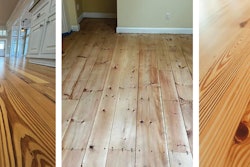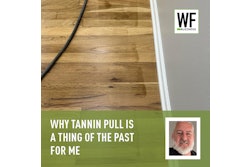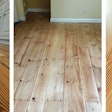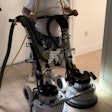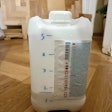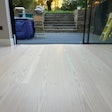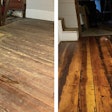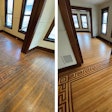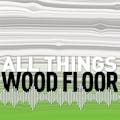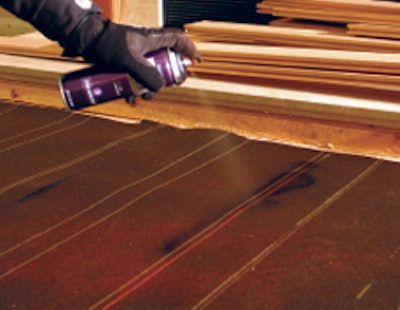
Drying Delays
I coated an ipé floor with poly yesterday morning. When I came back to put the second coat on today, the finish was still tacky. What's going on?
Bob Goldstein, technical director of Miami Beach, Fla.-based exotic wood flooring manufacturer Sabra International, answers:
Ipé (also known as lapacho or Brazilian walnut) floors by their nature are oily and prevent poly from curing. When coating ipé, it's a good idea to use a water-based sealer. Because the sanding process drives the natural oils deeper into the boards, this species must be coated immediately after the final screening to prevent the oils from coming back up to the surface of the wood.
This is a common problem with exotic species, such as cumaru/Brazilian teak, santos mahogany, massaranduba and many others. If you haven't coated a particular species in the past, check with your distributor or manufacturer before sanding and coating the floor.
Uneven Edges
My customer is complaining that there is too much overwood in the prefinished floor I installed. How do I know what's normal?
Frank Kroupa, technical advisor for the NWFA, answers:
There are some standards for prefinished flooring, but they may not apply to that product if the manufacturer isn't a member of that standards organization.
First, clearly define the problem. Is the overwood about the thickness of a business card? Is it really all over the floor? By this standard, most people find out they are being very picky. If the overwood is more than the thickness of a business card and it really is throughout the floor, the problem could be mismilling. But, it also could be lack of subfloor preparation. Moisture changes in the wood flooring also can compound these highs and lows.
Most flooring manufucturers have an allowance that 5 percent of the flooring doesn't have to meet their grade or criteria. That gives them lots of wiggle room. But remember, the floor man is the final inspector and is responsible for that floor—no one should really be allowing 5 percent of unacceptable product into the floor.
If the overwood falls into the range of what's to be expected, the problem comes back to customer expectations. The flooring contractor should always explain that the customer shouldn't expect a floor to be perfect.
Permeability Explained
I've heard people discuss the term "perm" rating for hardwood flooring underlayments. What does that mean?
Roger Barker, flooring specialist for Reno, Nev.-based moisture and vapor retarder membrane manufacturer Fortifiber, answers:
A "perm" (vapor permeability) rating measures the rate of moisture/vapor transmission through a membrane. The lower the perm rating, the slower the rate of moisture movement through a material. ASTM E96 is the commonly accepted test for measuring vapor transmission.
Using a vapor retarder between a plywood subfloor and wood floor reduces the rate of moisture transmission, allowing the wood floor time to adjust to changes in the moisture conditions underneath the subfloor. This reduces the potential for expansion, contraction, cupping, warping and other moisture-related problems, thereby improving your chances for successful installation.
A 6-mil poly falls into the impermeable moisture barrier category. While 6-mil poly is often recommended over concrete, for a hardwood flooring installation over plywood, you should use a semi-permeable or permeable moisture retarder that slows the moisture without trapping it. In the case of an impermeable vapor barrier, you risk trapping moisture underneath the membrane, on top of the plywood or within the plywood. This in turn can create problems with the plywood, such as warping, cupping or, in extreme cases, the growth of mold and mildew.
Acclimation 101
I've got gaps in the floor. We acclimated the flooring in the garage for a couple weeks, then it sat in the house for two or three days, and then we installed the floor. Two days later we sanded and finished the floor. It looked good for a while, but now that the heat's on, it has gaps.
Rusty Swindoll, assistant technical training director for the NWFA, answers:
The wood floor was not acclimated to the living conditions in the home. It took on moisture while it was in the garage, and when you brought it in and the heat was turned on, the floor started to dry and contract, leaving gaps. It's likely that the gaps won't go away in the springtime.
For future jobs, your first step is to get a moisture meter. When the flooring leaves the manufacturer, it should have a moisture content between 6 and 9 percent. When the flooring arrives at the job site, you need to check its moisture content. Check the subfloor moisture content, too. Before installation of strip flooring begins, the flooring and the subfloor moisture contents should be within four points of each other while the job site is at normal living conditions.

Trick of the Trade: Hold the Line
Chalk lines can often get fuzzy and smudged as workers move around the job site. To keep lines clear and accurate, use a cheap can of aerosol hairspray to spray the lines as soon as they’re snapped.














